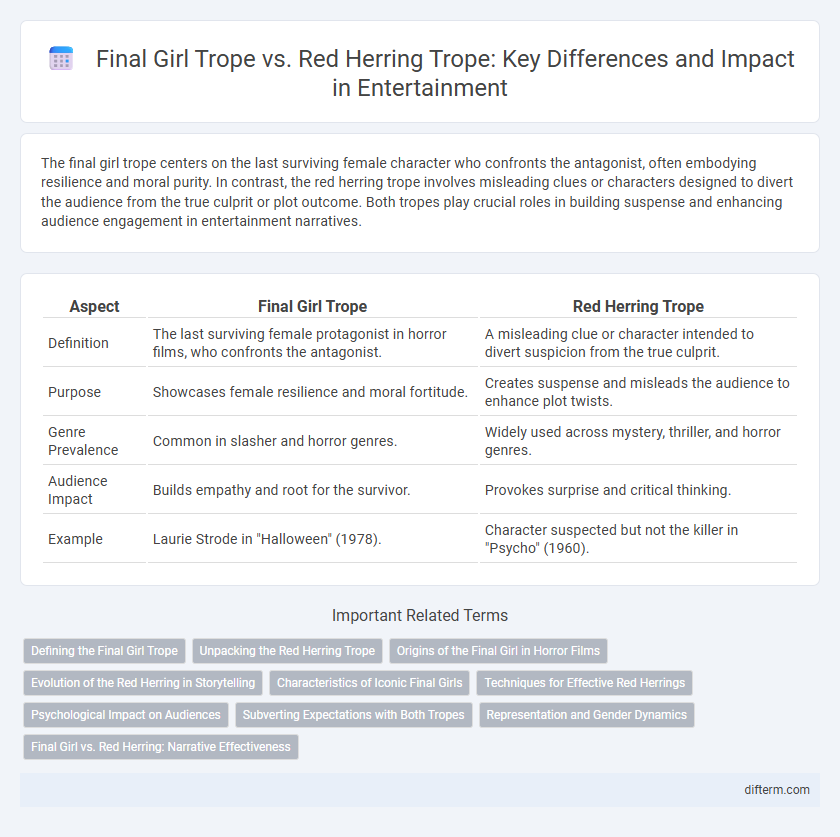The final girl trope centers on the last surviving female character who confronts the antagonist, often embodying resilience and moral purity. In contrast, the red herring trope involves misleading clues or characters designed to divert the audience from the true culprit or plot outcome. Both tropes play crucial roles in building suspense and enhancing audience engagement in entertainment narratives.
Table of Comparison
| Aspect | Final Girl Trope | Red Herring Trope |
|---|---|---|
| Definition | The last surviving female protagonist in horror films, who confronts the antagonist. | A misleading clue or character intended to divert suspicion from the true culprit. |
| Purpose | Showcases female resilience and moral fortitude. | Creates suspense and misleads the audience to enhance plot twists. |
| Genre Prevalence | Common in slasher and horror genres. | Widely used across mystery, thriller, and horror genres. |
| Audience Impact | Builds empathy and root for the survivor. | Provokes surprise and critical thinking. |
| Example | Laurie Strode in "Halloween" (1978). | Character suspected but not the killer in "Psycho" (1960). |
Defining the Final Girl Trope
The Final Girl trope in horror films refers to the last surviving female character who confronts the antagonist, often embodying innocence, resourcefulness, and resilience. This character contrasts with the Red Herring trope, where misleading clues divert attention from the true villain or survivor. The Final Girl serves as a narrative anchor, embodying moral strength and survival instincts that drive the story's resolution.
Unpacking the Red Herring Trope
The Red Herring trope misleads audiences by presenting a character or clue designed to divert suspicion away from the true antagonist, creating suspense and unpredictability in storytelling. Unlike the Final Girl trope, which centers on a lone survivor confronting the villain, Red Herrings function as narrative distractions that enrich mystery and horror genres. Effectively deploying Red Herrings enhances plot complexity by fostering engagement through false leads and unexpected twists.
Origins of the Final Girl in Horror Films
The Final Girl trope originated in 1970s horror cinema, characterized by a lone surviving female who confronts the killer, embodying resilience and moral strength. This archetype contrasts sharply with the Red Herring trope, where misleading clues divert attention from the true antagonist or survivor, creating suspense. The Final Girl's emergence reflects cultural shifts in gender roles and became a foundational element in slasher and horror film narrative structures.
Evolution of the Red Herring in Storytelling
The evolution of the red herring trope in storytelling has transformed it from a simple distraction to a sophisticated narrative device that deepens suspense and misdirection in entertainment media. Unlike the final girl trope, which centers on the survivor embodying resilience and morality, the red herring serves as a deliberate plot element designed to mislead audiences and complicate character motives. Modern stories leverage red herrings to enhance audience engagement by intertwining false clues with character development, making the reveal more impactful.
Characteristics of Iconic Final Girls
Iconic Final Girls exhibit resilience, intelligence, and moral fortitude, often surviving horror scenarios through quick thinking and resourcefulness. They typically embody purity and vulnerability, which contrasts sharply with other characters who may fall victim early on. This trope highlights a transformative journey from victim to survivor, setting the Final Girl apart from red herrings designed to mislead or distract the audience.
Techniques for Effective Red Herrings
Techniques for effective red herrings include misleading character motives by planting ambiguous clues and creating plausible suspects that divert audience attention from the true antagonist. Strategic use of false leads enhances suspense, while maintaining narrative coherence ensures the red herring aligns with the story's overall plot. Balancing subtlety with impact prevents predictability and keeps viewers engaged in the mystery.
Psychological Impact on Audiences
The Final Girl trope creates a psychological connection by embodying resilience and hope, often allowing audiences to experience catharsis through her survival against terrifying odds. In contrast, the Red Herring trope manipulates viewer expectations and heightens suspense by misleading audiences, triggering anxiety and uncertainty that intensifies emotional engagement. Both tropes exploit cognitive biases related to threat perception and moral alignment, deeply influencing audience empathy and fear responses in horror and thriller genres.
Subverting Expectations with Both Tropes
The final girl trope subverts audience expectations by centering the narrative on a resilient female survivor who confronts the antagonist, while the red herring trope misleads viewers with false clues about the villain's identity or motives. Combining these tropes enhances suspense and unpredictability, challenging genre conventions through unexpected plot twists. This blend keeps audiences engaged by simultaneously celebrating survival and complicating the mystery.
Representation and Gender Dynamics
The Final Girl trope centers on a solitary female protagonist who survives a horror scenario by embodying resourcefulness and moral strength, often challenging traditional gender roles through her resilience. In contrast, the Red Herring trope uses misleading clues or characters, sometimes employing female figures as distractions to subvert audience expectations and reinforce gender stereotypes. Representation in these tropes highlights evolving gender dynamics in entertainment, where the Final Girl offers empowerment and agency, while the Red Herring reflects lingering tropes that can perpetuate objectification or secondary roles for women.
Final Girl vs. Red Herring: Narrative Effectiveness
The Final Girl trope provides a compelling focal point for audience identification, driving the narrative through her resilience and survival, which enhances emotional investment and tension. In contrast, the Red Herring trope serves to mislead and create suspense by diverting attention away from the true antagonist or outcome, enriching narrative complexity. Together, these tropes balance predictability and surprise, optimizing audience engagement and thematic depth in horror and thriller entertainment.
Final girl trope vs Red herring trope Infographic

 difterm.com
difterm.com